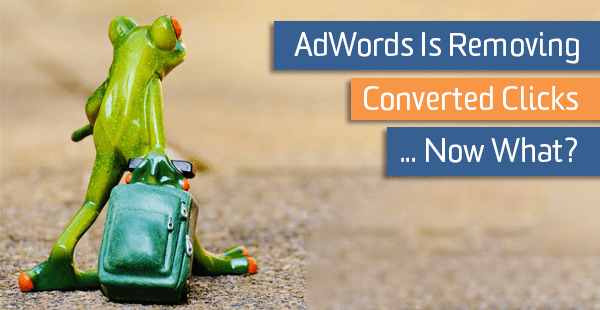AdWords Is Removing Converted Clicks. Now What?

While the paid search world was busy playing with the new toys AdWords recently rolled out, such as Expanded Text Ads, Google quietly announced it was retiring the “Converted Clicks” metric.
And while the September 2016 deadline has passed with the metric intact, don’t expect that to be the case for much longer.
So take a deep breath and we’ll go over how to contain your grieving for this beloved metric.
What Are “Converted Clicks”?
In order to understand why this announcement is important, it helps to understand what this metric represents.
Converted clicks were Google’s original metric for measuring PPC advertising success. Despite its place in the “Conversions” metric category, it’s actually a click metric that measures how many clicks lead to any number of conversion actions on your website.
So if someone clicked on your ad, filled out a contact form, signed up for mobile alerts, and bought a shirt, or five, or ten, you would see several “conversions” but only one converted click.
As conversion tracking became more nuanced, many advertisers stopped using converted clicks. However, several accounts have continued using this as a primary success metric.
In particular, it was good for advertisers who were tracking several goals that ultimately led to a similar outcome. For example, one of my clients tracked a few different goals that ultimately led to a user entering their CRM. It didn’t necessarily matter what or how many goals they completed, since the objective was to simply bring them into the sales process. For measurement, we just wanted to count unique leads and actions, and we used converted clicks to accomplish that.
Still, it was a large drawback that you couldn’t segment the data to drill into the specific types of conversion actions that were happening, nor could you assign these converted clicks any value.
Converted clicks also only recorded conversions that happened on the same device. Cross-device tracking? Converted clicks didn’t get the memo.

Apparently not
And for these reasons, Google sent in the Bobs to lay off converted clicks for good.

So wait, why should I care about some crusty old metric?
If you’ve been out of the converted click game for a while, you don’t have anything to worry about. Go about and enjoy the rest of your day!
However, if you still use converted clicks, you should care for a couple of reasons:
1. Reporting
Since the converted clicks metric will be dropped from the reporting interface soon, you will need to export your historical data if you want a record to compare performance against.
If you or your clients have used converted clicks as a success metric in the past, you will also have to determine an appropriate way to begin measuring success moving forward, as well as a method for making comparisons to past performance.
Because Converted Clicks and Conversions are counted differently, accounts switching from converted clicks to using the conversions will likely see an increase in reported conversions if they have multiple goals. Unfortunately, the lack of an annotation tool in AdWords at this time makes this task difficult. My recommendation would be to draw up some sort of project plan and history where you discuss strategy and measurement up to that point, and discuss the plan for the future.
Additionally, this inflation in conversion reporting also means that the change will impact…
2. Automated bidding strategies
If you are using any sort of automated bidding strategy focused on conversions, such as Enhanced CPC (eCPC) or Target CPA, and you are using converted clicks as the basis for bidding, you will no longer be able to do so. The system automatically switched to conversions for you in September.
Be aware that the influx of conversions may depress your CPA, potentially throwing off the Target CPA strategy you’re using.
Additionally, the sudden surge in conversions may cause your eCPC strategy to raise bids more often, raising your CPCs. This may not necessarily be a bad thing depending on your goals, but just be aware that it might affect reporting in the future.
What else do I need to do?
You may also want to review your conversion settings. I wrote about AdWords conversion settings here, but I’ll review two options here that you might want to re-examine:
3. Count

You have two options here for how conversions are counted:
Every: Count every time the tag fires after an ad click as a conversion. This is the option to use if you are tracking sales, since you want to accurately track revenue. So, if someone makes 5 purchases after their click, you will see 5 conversions.
One: This option counts more similarly to converted clicks and tallies only one conversion after an ad click. Choose this if you’re generating leads. If someone accidentally submits two forms, for example, you would only want to count one.
4. Include in “Conversions”

We also have the option to choose whether we want our conversion action to be included in the “Conversions” column for the purposes of reporting and automated bidding.
This can help you prioritize goals that you really care about for the purposes of adjusting your bids and reporting on success, bringing your conversion number closer to your converted clicks count.
If you decide not to include the goal in the “Conversion column,” don’t worry; you’ll still see it under the “All Conversions” column and in the “Conversion Actions” section of AdWords.
6. Check Cross-Device Conversions

Although conversions will now automatically count cross-device conversions in your conversion column moving forward, you also have the option to turn this off if you wish. Just go to Tools > Conversions > Settings and edit the “include cross-device conversions” tab.
Conclusion
Anyone who uses AdWords consistently knows the one constant is change. From Mobilegeddon, to the right hand rail ads disappearing, to the new ad formats and interface, it can be dizzying to keep up with it all.
The key, as always, is to not panic. Download your account data as a backup, check your bidding strategies and conversion settings, and everything will be alright.

You, after reading this post.


